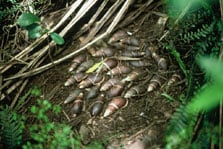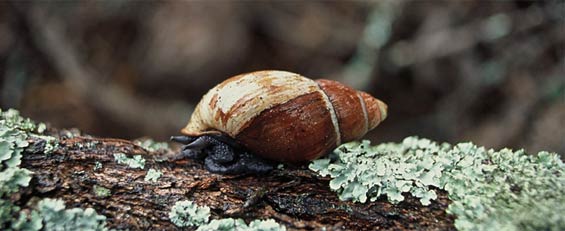Flax snail/pupurangi
Introduction
Flax snails usually live in broadleaf forest and scrub. Growing as big as 115 mm, flax snails/pupurangi are not your average garden snails.Flax snails/pupurangi (Placostylus spp.) belong to the group of northern giant land snails, which contain some of New Zealand's largest snails.
Facts
There are three species of flax snail:
- Placostylus bollonsi - up to 115 mm long (shell length), distribution: Three Kings Islands
- Placostylus ambagiosus - up to 94 mm long (shell length), distribution: Te Paki
- Placostylus hongii - up to 85 mm long (shell length), distribution: eastern Northland
These giants were once widespread in Northland before human settlement. Many of them are now endangered or threatened, and inhabit a more restricted area of Northland and the islands offshore.
Meet snail man David Roscoe - Conservation Blog 29 June 2012
Interesting ecology
- Giant snails may live to 20 years or more.
- Mating appears to be triggered by climatic conditions, such as rainfall, and can last for 10 hours or more.
- Snail hatchlings spend an unknown period living in trees and shrubs up to 6 metres above the ground.
- Flax snail diet includes fallen leaves from broadleaf plants.
Habitat
Flax snails usually live in broadleaf forest and scrub. They reside in pockets of broadleaf litter, or under ground cover vegetation.
Threats

Flax snail cluster under vegetation
The causes of decline for flax snails include:
- Habitat destruction - caused by humans
- Habitat modification - caused by domestic and feral grazers, including cows and horses
- Predation - by introduced animals, including rats, pigs and birds
- Collection of live animals for their shells may once have had an effect on population size
1080 poison helps native snails
Possums cause massive problems for New Zealand's native species.
The periodic use of the biodegradable poison 1080 to kill possums has reversed the decline in snail populations.

Flax snail habitat, Taupiri Island, Cape Maria van Diemen

Flax snail, Mokohinau Islands
DOC's work
Past conservation efforts
Management of priority flax snail colonies has been carried out since the early 1980s. Most of this management has consisted of rodent control, enhancement planting, fencing colonies and stock control. These actions have successfully allowed some species of flax snails to recover from near extinction to colonies of some hundreds.
Research has also been conducted on different aspects of snail ecology.

Flax snail having a transponder attached
Recovery Plan in action
The first Department of Conservation Giant Land Snail Recovery Plan was approved in 1995 and is currently being updated. The new plan sets in place a series of steps that will promote the recovery of the snails. It also outlines different management options and a work plan.
The long-term goal of this recovery plan is:
'To preserve and enhance populations of all Placostylus and Paryphanta species, and Rhytidarex buddlei in their natural range. The emphasis is to direct management towards the most genetically and morphologically distinct and viable populations.'
Goals for the term of the plan:
- To encourage and support public and community protection of northern giant land snails and their habitat throughout the term of this plan.
- To secure representative populations of distinct taxa.
- To conduct research required for effective management.
DOC welcomes any comments or suggestions you may have about the conservation of giant snails. These can be directed to the recovery group via any DOC office.
You can help
These are some of the things you can do to help if you have giant land snails on your property:
- Fence off areas of bush where the snails are present. This will stop stock from trampling and crushing them.
- Control rodents, as they prey on juvenile snails. Snail populations greatly benefit from rodent control.
- Control pigs. They are also a predator, and eat adult snails as well as damaging snail habitat through rooting.
DOC welcomes any comments or suggestions you may have about the conservation of giant snails. These can be directed to the recovery group via any DOC office.
